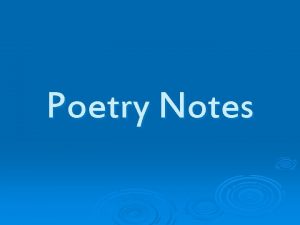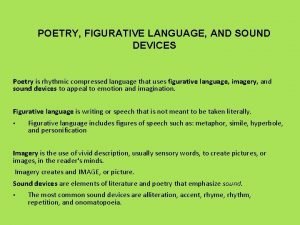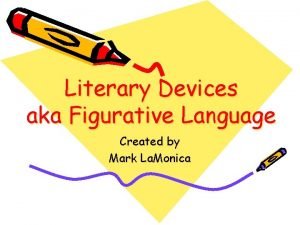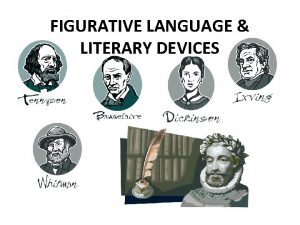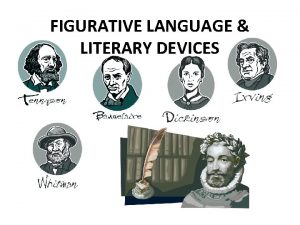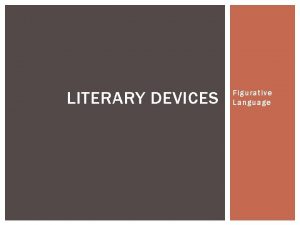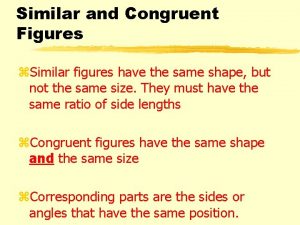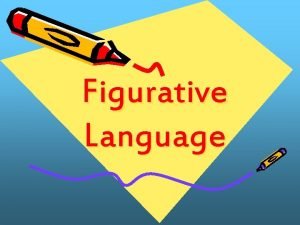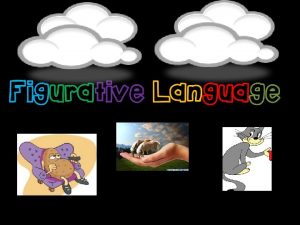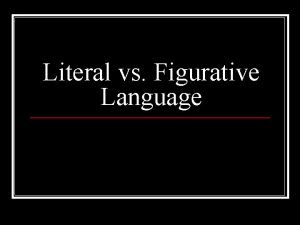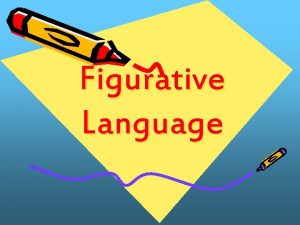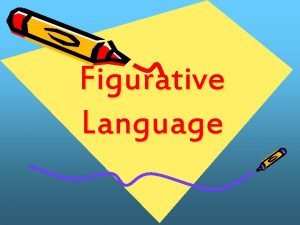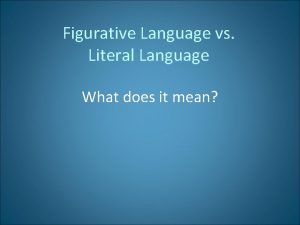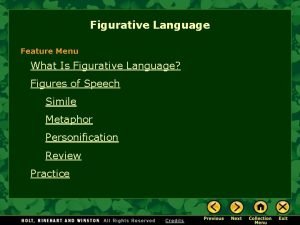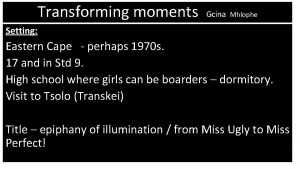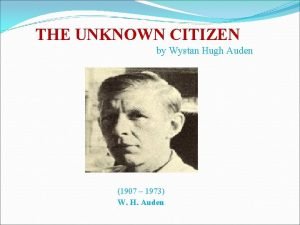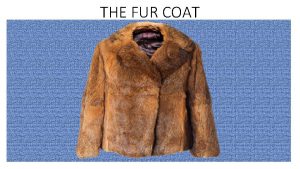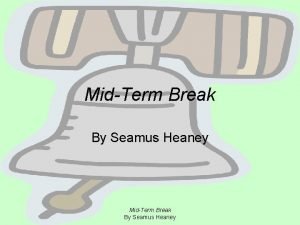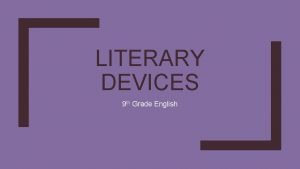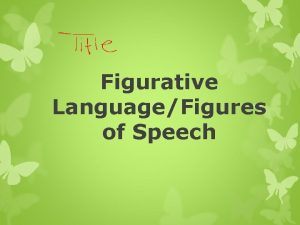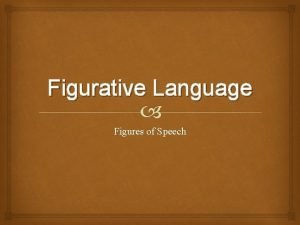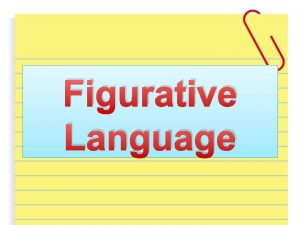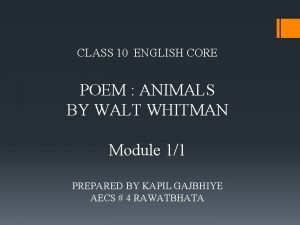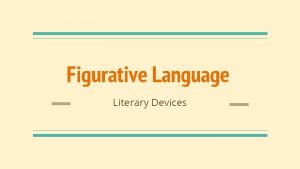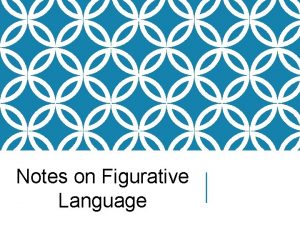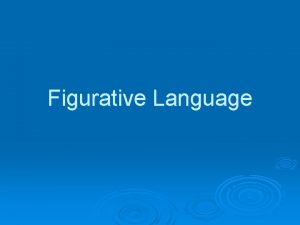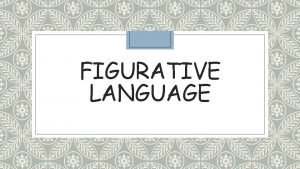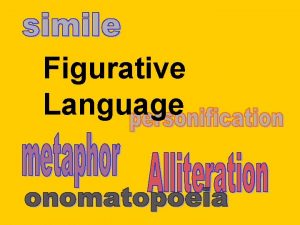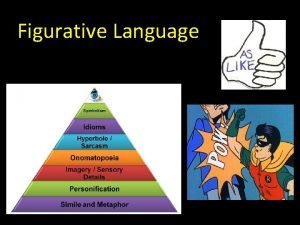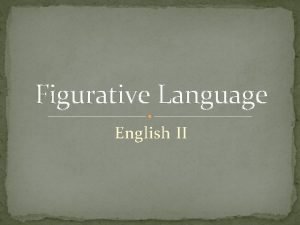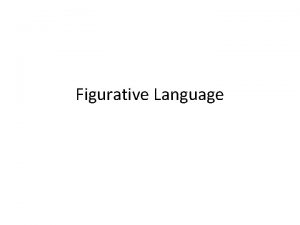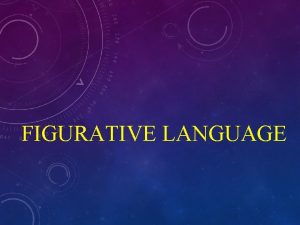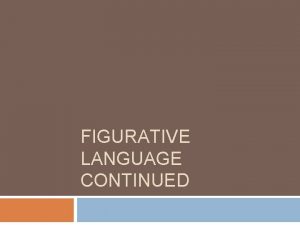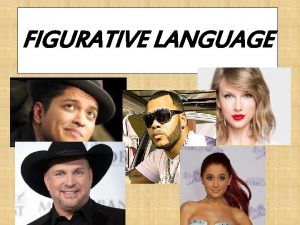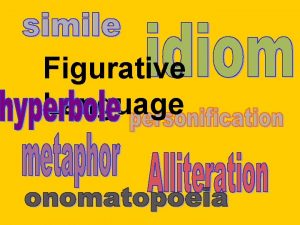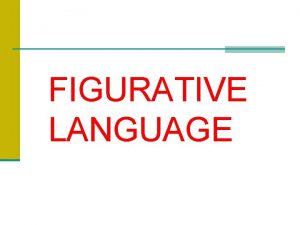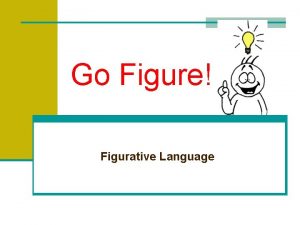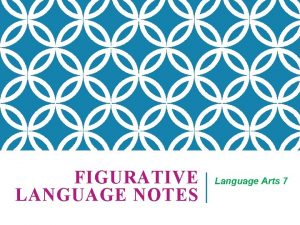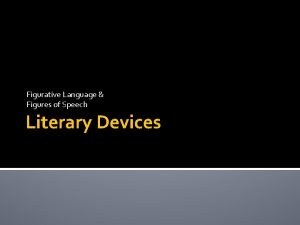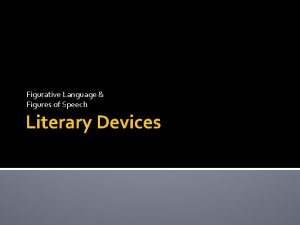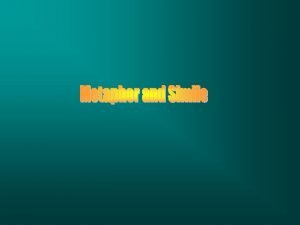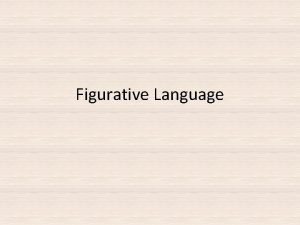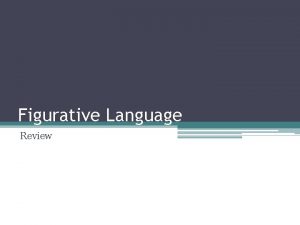Figures of Speech Figurative Language Literary Notes Section





























- Slides: 29

Figures of Speech (Figurative Language) <Literary Notes Section>

• Metaphor: indirect comparison made between two unlike things (without using “like” or “as”) – Ex. : “My baby sister is a doll. ” • Simile: comparison between two things using “like” or “as” (“than, ” “similar to, ” “resembles, ” “appears, ” or “seems”).

• Symbol: a thing (object, person, situation, or action) which stands for something more than itself. – Ex. : The American flag -> freedom/US; 50 stars -> 50 states • Personification: giving a nonhuman thing human-like characteristics – Ex. : “The tree danced in the breeze. ”

• Hyperbole (overstatement): an exaggeration of the truth that is not intended to be taken literally. – Ex. : “I had so much fun shopping yesterday that I spent a billion dollars. ” • Understatement: saying less than is true – Ex. : “Wow, I just saw you fall of the roof! Did that hurt? ” “Just a little…”

• Irony: a contrast/discrepancy between what is expected/said and what really happens/truth – Dramatic irony: the reader knows something that a character does not – Verbal irony: what is being said is not true (like sarcasm) – Situational irony: a twist in the story in which something happens which both the reader and character(s) did not expect

• Alliteration: repeated consonant sounds occurring at the beginning (within) words – Ex. : “Sally sells seashells by the seashore. ” • Onomatopoeia: a word that imitates a sound – Ex. : “hiss, ” “buzz, ” “snap”

• Apostrophe: addressing something that cannot respond (absent/dead person, something nonhuman, an abstract, etc. ) – Ex. : “Why you got to die, puppy? ” • Allusion: in reference to a statement, person, place, thing, literature, sports, TV, history, etc. • Antithesis: a contrast of ideas expressed in a grammatically balanced statement. – Ex. : “…wretches hang so that jurymen may dine. ”

• Synecdoche: a part of a thing that stands for the whole – Ex. : “All hands on deck!” • Idioms: groups of words whose meaning is different from the ordinary meaning of the words. – Ex. : “Put a lid on it!” “Take a hike!” “Cat got your tongue? ” “Don’t let the cat out of the bag!” “He came out the closet. ”

Copy the following vocabulary: Rank – adj. Growing too thickly and coarsely. Write your own sentence example: The clover grew rank under the tree. Untenanted - adj. Un – not, not occuppied The old house was untenanted. Grindstone – noun -A thick disk of stone mounted so as to revolve, used for grinding, sharpening, or polishing metal objects. Idiom: keep your nose to the grindstone

Create two compound sentences utilizing at least three of the vocabulary words: • Accidentally, awkwardness, discouraged, exotic, hazy, monotony, spectacular, unbearable. Example: I accidentally forgot to bring my exotic plant inside, and the cold was unbearable for it. The monotony of her voice was unbearable, so I made a spectacular scene and left the room.


“The Scarlet Ibis” Guidelines for Notes (Period 1, 384) • Definition of “ibis”: • Definition of “allegory”: • Characters: – Narrator – Doodle • • Point of View Setting Plot Conflict(s) Irony Symbolism Theme Climax/Resolution

“The Scarlet Ibis” Notes (4 th Period, 384) Define “allegory”: a story or poem in which every element has parallel literal or symbolic meanings. • Define “ibis”: • Setting: Time and place • Characters – Narrator – Doodle • • Plot: Point of view: Irony: Conflict(s): Rising/Falling Action: Theme(s): Unknown terms:

“The Scarlet Ibis” Figures of Speech Chart (384) Figure of Speech Example Ex. : symbol The scarlet ibis represents Doodle. Ex. : metaphor/ personification “…summer was dead but autumn had not yet been born…” (384) Directions: Find 10 figures of speech in the story. You may not repeat a particular figure of speech more than 3 times. 1. 2.

Copy the following compound sentence. Idententify: subjects, verbs, etc. • “The Scarlet Ibis” took place during President Wilson’s presidency, and Brother and Doodle were the main characters.

Examine the following conversation from “The Scarlet Ibis” "Do you want to be different from everybody else when you start school? " "Does it make any difference? " "It certainly does. " Here, an older brother is coaching his younger brother, who has physical disabilities, on how to fit in while in school.

• Why is it that we sometimes fear people who are different? • Why do many people think it's so important to fit in? • If someone doesn't mind being different, why do we often still pressure them to conform? • This story shows that pushing others too hard to fit in can end in tragedy

Common theme or idea: • In both “Glass Castle” and “The Scarlet Ibis” the narrators share a common feeling of shame or embarrassment over someone close to them. Both were terrified of not fitting in. • What are some reasons we feel embarrassed by others? – We want the approval of others – We want to fit in – We want to feel accepted

Making Inferences: • “Doodle was just about the craziest brother a boy ever had Of course, he wasn’t a crazy like old Miss Leedie, who was in love with President Wilson and wrote him a letter every day, but was a nice crazy, like someone you meet in your dreams. ” • What can you infer about setting? ____ • What can you infer about the way the narrator felt about his brother? __________

Inferences? • Daddy had Mr. Heath, the carpenter, build a little mahogany coffin for him. ” • “It was bad enough having an invalid brother, but having one who possibly was not all there was unbearable, so I began to make plans to kill him by smothering him with a pillow. ” • What might you be able to infer about the Narrator?

What can you infer from the following quotes? • “…. Daddy built him a go—cart and I had to pull him around. . . it ended up by my having to lug him wherever I went. ” Infer how brother felt about this? • “A long list of don’ts went with him, all of which I ignored once we got out of the house. ”

“I could see I was licked. Doodle was my brother and he was going to cling to me forever…. so I dragged him across the burning cotton filed to share with him the only beauty I knew. Old Woman Swamp. ” “Then he began to cry. … ‘It’s so pretty…So pretty, pretty. ” What can you infer about Doodle?

Exemplary Response to the Question Score Point 3 • A – Answer: The idea is perceptive and reflects an awareness of the complexities of the text. The student is able to develop a coherent explanation of the idea by making discerning connections across the text. • B – Bring in text: The text evidence used to support the idea is specific and well chosen. Overall, the evidence strongly supports the validity of the idea. • C – Connect text and answer: The combination of the idea and the text evidence demonstrates a deep understanding of the text.

“The Scarlet Ibis” Open-Ended Question Guide Remember the three steps when giving a short answer to an open-ended question: 1. A- Answer the question. 2. B- Bring in text - Support your answer with a quote (evidence). 3. C – Connect text and answer - Analyze (examine and dissect) the quote and connect it to your answer.

. Answer the question: • What is the significance of the scarlet ibis? Support your answer with evidence from the story. • The scarlet ibis is used as a symbol to signify the character Doodle.

. Support your answer with a quote. (Make it as concise—to the point—as possible. Identify the most important words in the quote. ) • “At that moment, the bird began to flutter, but the wings were uncoordinated, and amid much flapping and a spray of flying feathers, it tumbled down, bumping through the limbs of the bleeding tree and landing at our feet with a thud. Its long, graceful neck jerked twice into an S, then straightened out, and the bird was still. A white veil came over the yes and the long white beak unhinged. Its legs were crossed and its clawlike feet were delicately curved at rest. Even death did not mar its grace, for it lay on the earth like a broken vase of red flowers, and we stood around it, awed by its exotic beauty. • Doodle’s family observes the ibis, which “…began to flutter, but the wings were uncoordinated, and…it tumbled down …Even death did not mar its grace, for it lay…like a broken vase of red flowers…” (393).

. Analyze the quote The imagery of the ibis correlates closely to Doodle’s death, as he, too, “lay very awkwardly…making his vermillion neck appear unusually long. . His little legs… never before seemed so fragile…” The hues of red suggest blood, which emphasizes the disturbing death of both the ibis and Doodle. The physical characteristics of the bird and the boy are parallel, as the “broken vase” can represent the broken and fragile body of Doodle. The ibis symbolizes Doodle, both frail and broken. (Notice that I used direct quotes to find comparisons between Doodle and the ibis. )

Single answer response: • What is Brother’s motive in teaching Doodle to walk? Support your answer with text.

Common theme or idea: • In both “Glass Castle” and “The Scarlet Ibis” the narrators share a common feeling of shame or embarrassment over someone close to them. Both were terrified of not fitting in. • What are some reasons we feel embarrassed by others? – We want the approval of others – We want to fit in – We want to feel accepted
 Figurative language in poetry
Figurative language in poetry Rhyme
Rhyme Literary devices in fiction
Literary devices in fiction Literary devices figurative language
Literary devices figurative language Repetition in language
Repetition in language Assonance examples
Assonance examples Figurative language and literary devices
Figurative language and literary devices Ano ang tayutay
Ano ang tayutay Two shapes that are congruent are also similar
Two shapes that are congruent are also similar Plane figures and solid figures
Plane figures and solid figures Start area
Start area Literal vs figurative language
Literal vs figurative language Figurative language
Figurative language Figurative vs literal
Figurative vs literal Literal language is for
Literal language is for Figurative or literal language
Figurative or literal language What is the difference between idiom and hyperbole
What is the difference between idiom and hyperbole Is figurative language a language feature
Is figurative language a language feature Transforming moments by gcina mhlophe summary
Transforming moments by gcina mhlophe summary The unknown citizen poem
The unknown citizen poem Summary of the fur coat
Summary of the fur coat He is the black sheep in the family figure of speech
He is the black sheep in the family figure of speech A figure of
A figure of My last duchess conclusion
My last duchess conclusion What is the poem mid term break about
What is the poem mid term break about Extended metaphor definition
Extended metaphor definition Personification meaning figure of speech
Personification meaning figure of speech Antithesis figurative language
Antithesis figurative language Litote examples
Litote examples Who is unhappy over the whole earth
Who is unhappy over the whole earth
